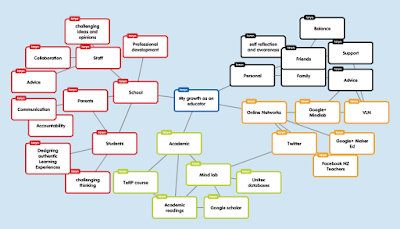Interdiscipinary Connections
My interdisciplinary connection map (created with Popplet) shows the connection between developing knowledge, points of view and support from others, and experiences. All together this shapes my learning experiences as an educator. I need all the aspects in order for my learning experiences to be authentic and therefore I am able to take my learning back to my daily life and apply it. If this is how MY learning is shaped, then you can see the need for interdisciplinary learning within the classroom.
From my map, there are a couple of areas I need to work harder on in order to keep my growth as an educator going. In fact, there will ALWAYS be areas to improve on... perhaps this is what makes a life long learner! Firstly, I need to become better at interacting online so I am consistently engaging with fellow educators and therefore continually developing my knowledge based on my own and others' points of view, receiving and sharing of new and exciting ideas and further professional research and readings. The barrier for me here is that I sometimes find it difficult to see the value in offering my opinion to others. A personal barrier I will have to continue to work through.
Secondly, I would like to break down the barriers of using technology effectively in the younger age group. I think in order to do this I need more support from parents in policing children at this age. As I've mentioned in my previous blog post, it really is a worry that children are not emotionally mature enough to manage using the social and online aspects of using technology to enhance their learning. Therefore I think we need a parent/ teacher partnership that teaches these young students what is appropriate and what is not. We can't assume that a child will instinctively know how to behave, it needs to be explicitly taught.
However, tying this use of technology in with the students learning in an interdisciplinary way will be the most effective way to nurture their use of technology.
The main goal of interdisciplinary learning within the classroom is to help students synthesize knowledge and then make connections to everyday living, therefore have meaningful learning experiences. The inclusion of an individual's experiences, points of view and background are all important to the knowledge being developed (Mathieson & Freeman, 1998).
The benefits of this way of learning are obvious, student engagement increases and is reflected in any assessment of the learning made. For my younger age group, the Olympic games coming up will be an ideal umbrella theme for interdisciplinary learning. Tying in the core subjects to this allows us to incidentally explore learning under the guise of the Olympics! Imagine the exploration we can do of other countries and lifestyles, flags of the world and our recent NZ flag debate, measurement such as length and speed, skyping some of our NZ athletes there, perhaps a twitter conversation with a school in another country... the list goes on!
However, this type of learning comes with its drawbacks, it is often time-consuming to plan. We have an advantage at our school that we collaborate and team teach, and so if done with the correct amount of collaboration we each can go away and plan aspects of this project based learning style and then hopefully teach with passion and energy. This needs to be done carefully so that each person has a fair share of the work load. It takes a fair amount of communication and sometimes an attitude of "we're doing this for the love of teaching and learning!"
But, the benefits outweigh the drawbacks. Students and teachers advance in critical thinking, creativity, communication and essential knowledge (Jones, 2009).
References:
Jones, Casey (2009) "Interdisciplinary Approach - Advantages, Disadvantages, and the Future Benefits of Interdisciplinary Studies,"ESSAI: Vol. 7, Article 26.Available at: http://dc.cod.edu/essai/vol7/iss1/26
Mathison, S., & Freeman, M. (1998). The Logic of Interdisciplinary Studies. Report Series 2.33.



Support from parents is definitely key when using technology with younger students! I really agree with what you say about emotional maturity too. Explicit teaching and a quality parent/teacher partnership is definitely the way to go. I found community consultation really helpful at our school, as so many parents had questions about e-learning.
ReplyDelete